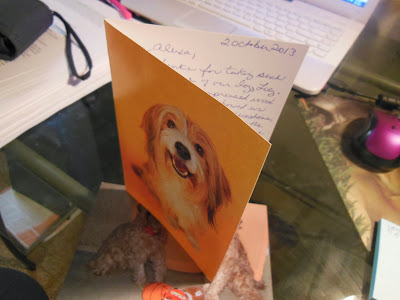Friday was my last day of a 2 week rotation in oncology. Oncology refers to the study of cancer and on this rotation I saw patients that were being treated for various forms of cancer. It may sound like a sad rotation because there no cure for cancer and our main goal was to maintain a good quality of life for as long as possible. It was sad at times but it was also rewarding to get to know the patients and their owners and see how much these people cared about there pets.
I was able to do more doctor-like things on this rotation like bringing animals into an exam room, doing a physical examination and take a thorough history from owners. After that I would leave the room and report my findings to one of the oncologists or residents and after discussing it we would go back in and they would ask more questions and do an exam themselves. After this they would talk about treatment options or changes to the current treatment regimen. Some animals received chemotherapy and it was neat to be a part of that and see all the extra safety precautions taken when administering those drugs.
It was a very busy rotation but that made it go by fast. I got better at drawing blood from the jugular vein in the neck of dog and cats. I got better at taking fine needle aspirates of skin masses and staining them to look at under a microscope. I also got better at feeling all the lymph nodes although there were certainly a few that I missed and I was glad that I wasn't the only one checking for enlarged or firm lymph nodes. I got better at writing discharge papers for owners telling them what we did to their pet that day and providing information about their pet's particular form of cancer. I learned about a lot of chemotherapeutic agents, when to use them, and common side affects associated with them. I learned about different treatments for many types of cancer. Surgery, Chemo, and radiation are common treatment options for animals. Some of my patients needed x-rays, ultrasounds, or CT scans to determine the extent of the disease to help owners make treatment decisions.
 |
| Supplies needed for a fine needle aspirate (FNA) - Pic from the web. |
I feel like I worked hard and tried to do my best on this rotation. There was a really steep learning curve at the beginning because I was not yet familiar with the computer system used in the hospital or the main protocols like submitting blood work or writing prescriptions. Each day started at 8 am and the time I left varied a lot. The earliest I ever left was 5 pm and the latest was 8 pm.
Overall, I'd say that I enjoyed this rotation but I'm also glad that it's over. I had a total of 24 patients and I saw 3 of them twice. It was nice to see a patient that I'd already seen previously because I already knew their history and what we were doing for them.The most common types of cancer that my patients had were lymphoma, mast cell tumors, and melanomas. The most common breed of dog that I saw was Golden Retriever (5).
I wish I had some great pictures from this rotation but unfortunately I do not because we are not allowed to post pictures of patients in the hospital. My next rotation will be 1 week in clinical pathology.





































































